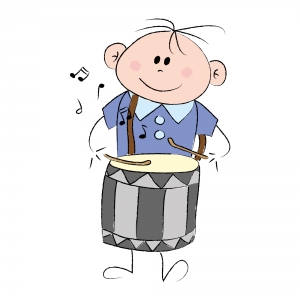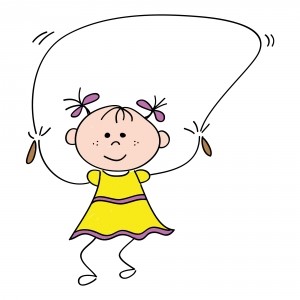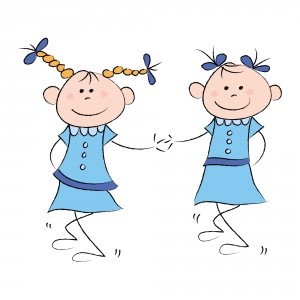By Craig Valency, MA, CSCS
Introduction
As I discussed in my introductory post, the missing link to true movement mastery is learning the 9 perceptual-motor skills as early as possible.
As fitness professionals, teachers, therapists, or parents, we have a unique opportunity to even the playing field by offering every child we work with an ideal environment to explore movement through all their senses.
These skills lay the foundation for an increased movement vocabulary with overall better coordination and the ability to learn the fundamental movement skills. With this foundation firmly in place, children are better equipped and more likely to engage in sports and recreational activities for a lifetime.
Here is a bird’s eye view of the 9 perceptual-motor skills we’re looking at in this series:
- Body: Understand the parts of the bodies and how they move
- Directional: Differentiate between the left and right sides of the body and move in all planes of motion
- Spatial: Has a sense of how much space one’s body takes up and moves comfortably around other people and objects
- Temporal: Has a sense of timing and rhythm
- Visual: Can visually focus and track objects
- Vestibular: Develop an internal sense of their body’s position in relation to gravity
- Auditory: Can accurately respond to sound
- Tactile: Can respond to touch in competitive situations to counter a move, as in wrestling, or in cooperative situations to stay with a partner, as in dance
- Proprioceptive: Interpret the internal sense of where the body is in space
Today, I’ll focus on temporal awareness and discuss why it is so important to overall coordination and movement efficiency. I’ll outline what it is and give specific ideas that you can use to teach temporal awareness in any youth fitness program.
What is temporal awareness?
Temporal awareness refers to the development of internal timing. When temporal awareness is well developed, children are able to properly sequence and synchronize movements with a sense of rhythm. Eye-hand and eye-foot coordination are the result of proficiency in temporal awareness (Gallahue, p. 116).
With the development of temporal awareness, children begin to differentiate regular and irregular rhythms, long and short time intervals and fast and slow stepping.
Developing a sense of timing and rhythm not only improves coordination and movement proficiency, but it has a unique role in improving learning as well. The ability to distinguish rhythms has been linked to the capacity to understand grammar. The rhythm of speech helps kids sort language into words and phrases. If kids become skillful in distinguishing musical rhythm through body movements and dance, they may be better at interpreting rhythmic variations in speech, which would improve language skills. (Reyna L. Gordon, Carolyn M. Shivers, Elizabeth A. Wieland, Sonja A. Kotz, Paul J. Yoder, J. Devin McAuley. 2014)
Teaching temporal awareness
 A great way to instill a sense of temporal awareness is to first bring awareness to the rhythms of life that are all around us on a macro level. Looking through a temporal lens, it’s up to us to simply create the awareness of events such as the repeating nature of the day (morning, afternoon, and night), the seven days of the week, the weekend and the four seasons. (Elena, et al, 2013, p. 633). Other ways to emphasize this include having regular meal times, play times, bed times, holiday celebrations, and other events that allow children to create a frame of reference for the passage of time.
A great way to instill a sense of temporal awareness is to first bring awareness to the rhythms of life that are all around us on a macro level. Looking through a temporal lens, it’s up to us to simply create the awareness of events such as the repeating nature of the day (morning, afternoon, and night), the seven days of the week, the weekend and the four seasons. (Elena, et al, 2013, p. 633). Other ways to emphasize this include having regular meal times, play times, bed times, holiday celebrations, and other events that allow children to create a frame of reference for the passage of time.
Teaching temporal awareness on a personal, internal level involves making kids aware of the speed, timing, or rhythm of the activities they are doing. It is also important to speak literally about time expectations. Don’t say, “I’ll be there in a minute!” if you mean 5 minutes. If they have 2 minutes to clean up, make sure you time it exactly so they develop a better frame of reference for the passage of time.
Here are 8 fun ways to shine the light on temporal awareness with kids:
- Turtle, Elephant, & Cheetah – This can be used in a whole class warm-up. Just as we did with body awareness and directional awareness, start by calling out body parts that they have to identify with a specific (right or left) hand, foot, elbow, etc. For example, “Touch your right knee with your left elbow.” Next, introduce the elements of tempo for how you want them to move their body: either at a slow, fast, or medium tempo. Here are a few examples of how to do it:
- With arms outstretched to the sides of your body, move hands in slowly. Right before they touch then move them apart fast, then do the opposite. Move them at a medium tempo both ways, etc.
- Start with both arms outstretched in front of your body with both hands in a fist. Open hands fast and close hands (make a fist) slowly, etc.
- Arm circles – slow/ fast/ medium
- Squat – slow/ fast/ medium. Go down one tempo and up a different tempo, etc.
- Imaginary climbing – slow/ fast/ medium – up the rock fast and down slowly, etc.
 Now transition by asking them which animal is the fastest – the turtle, elephant or cheetah. Then ask which is the slowest. Point out that the elephant must be somewhere between the turtle and the cheetah. Now have them move various body parts at various tempos by calling out the animals rather than the speed. This allows kids to start to relate these variations in tempo to the wider world around them and create more context for variations in tempo.
Now transition by asking them which animal is the fastest – the turtle, elephant or cheetah. Then ask which is the slowest. Point out that the elephant must be somewhere between the turtle and the cheetah. Now have them move various body parts at various tempos by calling out the animals rather than the speed. This allows kids to start to relate these variations in tempo to the wider world around them and create more context for variations in tempo.
- Move to the beat – Have the kids move around each other in a general or restricted space using various locomotion patterns such as a walk, skip, hop, march, jog, crawl, etc. Once they are warmed up, have them do the movements at the same tempo that you are clapping. You can use a tambourine or other rhythm instrument as well.
- For example, “On my signal, everybody skip throughout the space marked by the cones, and try not to bump into each other. Try to move to the beat that I’m playing.”
Another way to build awareness of keeping the beat is to have half the class clap along with the teacher’s beat while the other half does the locomotion activity that is called out by the teacher, then switch.
- March n’ clap – This is a great way to teach how to subdivide a beat and create a sense of whole body rhythm. Start by having the kids model you as you march slowly in place. Have them count each step along with you, “1, 2, 3, 4,” “1, 2, 3, 4…” Now add the subdivision by clapping each time one foot is raised off the ground. So now it is, “1 & 2 & 3 & 4 &.” Each number is a foot stomp and each “&” is a clap. Now gradually start changing the tempo. The faster it goes the harder it will be to keep up!
Once they master this tempo subdivision based on 4 beats, they can try one based on 3 beats, like the rhythm used in a waltz. This will start with a clap then 2 steps, “Clap, 2, 3, clap, 2, 3…” Begin with right leg each time. Then do it again beginning on the left leg.
- CODS – These are “change of direction speed” drills, not reactive agility drills. Use cones, lines, or low hurdles to work on simple rhythmic patterns such as:
- Cone weaves forward, backward and sideways
- Cone weave complete circles
- Cone weave sideways
- Lateral high knees over the cones
- Low hurdle jumps, hops, and high knees forward, backward, and sideways
- Low hurdle right leg over only, and then left leg over only, then both feet over going down the middle
- Agility ladder patterns with 2 steps, 3 steps or 4 steps, cross over steps, hops, and jumps, forward, backward and sideways
“If they can sing it they can move it!” For the ladder drills a great way to teach the more complex patterns is to have them self-cue by chanting the pattern while they do it. This reinforces the rhythmic pattern. For instance, “In, in, out, out,” “Right, 2, 3; left, 2, 3” or, “Cross, 2, 3,” etc.
Once the rhythmic patterns look good and even, place the cones or hurdles at varying distances to allow them to work on irregular rhythmic patterns where they have to transition as smoothly as possible.
- Jump rope – There is no better way to teach a sense of timing and rhythm than a jump rope. The rope is a perfect self-correcting tool that will always let the kids know when their timing is perfect or slightly off. If they can get over the rope their timing is right!

“Cinderella dressed in yellow, went upstairs to kiss a fella…” There is a good reason we’ve all grown up hearing those jump rope sing along rhymes – they work! Find some fun jump rope chants and have the kids practice this way. Just as with the ladder drill above, this “sing along” strategy reinforces total body rhythm.
Another good strategy is to have the kids subdivide the beat as we did in the “March n’ clap” drill above. They should hop over the rope, then add in an extra hop when the rope is over their head, making sure to keep a steady beat. This helps them feel the beat in between and better measure time. Many (if not most) kids don’t really learn to jump rope until they learn to subdivide their jumping tempo.
If they can’t get over the rope at all, start with an imaginary rope. Once they can keep time, put the rope in just one hand and let them hear the rope hit the ground as they hop, so they can get accustomed to what is supposed to happen at the right time.
Besides jumping rope solo, they can also use the large rope with 2 rope turners and alternate the jumper once the person misses or when the rhyme is over.
Here are some basic jump rope variations.
- Jump with 2 feet: forward & back; side to side; twist
- Jump with alternating feet: high knees; heel, heel, toe, toe
- Jump with single foot: 1 foot for 3 hops, then switch, then 4 hops, etc.
- Backward rope turning
- Gear runs – This is a great way to let kids experience what true top speed is, versus half speed, three quarter speed, quarter speed, or walking. Tell them they are all a sports car with 4 gears. 1st gear is slow (a jog), 2nd gear is half speed, 3rd gear is three-quarter speed, and 4th gear is top speed (moving as fast as they can). (Lentz, D., & Hardyk, A., 2005).
First, call out the gears in order and have them pick up speed gradually. Then call them out in random order and see how well they can modulate their speed, decelerate, reaccelerate, and properly subdivide the tempo.
- Variations: Add in “brake” & “reverse” commands
- Dance – The true essence of temporal awareness is through the total body response to music, or what we all know as dance! First teach specific dances (square dance, electric slide, the Nae Nae) so kids can learn the possible ways their body can move to a beat, and so they can see if they are keeping up with everyone else on beat. Next, allow for free expression dance. Begin with body parts first as they move just their arms, legs, head, 1 arm 1 leg, etc. to the music, then let them just freely express themselves with dance, with no judgment about the right or wrong way to dance.

John Ratey, author of “Spark,” a book about the connection between exercise and cognitive development, asserts that as the complexity of movements increase, more synaptic connections are made. Ratey highlighted a study in dancers that showed moving to an irregular rhythm, as opposed to a regular rhythm, improved brain plasticity to an even higher degree. And most importantly, although these new neural circuits were created as a result of increased movement, they could be recruited by the brain for mental processing as well (p. 56).
- Interception! – The most advanced level of temporal awareness is being able to predict when an object will arrive, as in bouncing, catching or hitting a ball, or avoiding an object.Although it varies with each individual, please keep in mind that a child’s eyeball shape and focal point is not fully developed until anywhere from six to nine years of age. Doing these activities will help accelerate the process but children may simply not be developmentally ready for more advanced interception timing activities. Here are some ideas onprogressing interception skills:
- Catching or popping bubbles
- Toss and catch scarves
- Toss and catch beanbags or oversized balls
- Intercept a rolling ball by tossing another ball (as one child rolls or tosses another tries to hit it)
- Hitting a ball alone with a paddle or racket
- Hitting a ball with a partner with a paddle or racket
- Hitting a ball with a bat
- Dribble a large, light ball, a basketball, a tennis ball
- Dodgeball
- Partner tag
Conclusion
The key to teaching temporal awareness to children is to first create an understanding of the temporal nature and rhythms of the wider world around them. Next, get kids keyed in on timing and rhythm with activities that they do every day such as moving parts of their body or their whole body at various tempos, as well as trying to keep time with tempos that you set. Treat agility and speed drills more as opportunities to groove rhythmic patterns than technical performance drills. Open-ended activities, such as jumping rope and dancing, are great ways to build a sense of whole body timing and rhythm and are a fun way for kids to express themselves through movement. Once kids master the basics of temporal awareness, they will be able to better predict when an object or another person will arrive, such as in catching or hitting a ball or making sure they avoid getting hit by an object or person coming their way.
In part 6, I’ll talk about Visual awareness, or the ability to either track objects or focus on a stationary point while simultaneously engaged in other activities. I’ll talk about ways to help kids improve their visual focus and tracking ability. I’ll also explain special considerations with kids regarding the timing of eye development that may impact their ability to excel in specific sports or activities.
References
Elena, S., Georgeta, N., Cecila, G., & Lupu, E. (2013). Perceptual-motor development of children in elementary school. Procedia Social and Behavioral Sciences, 114, 632-636.
Gallahue, D., & Cleland Donnelly, F. (2003). Developmental Physical education for all children (Fourth ed.). Champaign, Illinois: Human Kinetics.
Lentz, D., & Hardyk, A. (2005). Speed Training. In L. Brown & V. Ferrigno (Eds.), Training for Speed, Agility, and Quickness (Second ed., p. 49). Champaign: Human Kinetics.
Ratey, J., & Hagerman, E. (2008). Spark: The Revolutionary New Science of Exercise and the Brain (First ed.). New York, New York: Little, Brown and Company, Hachette Book Group.
Reyna L. Gordon, Carolyn M. Shivers, Elizabeth A. Wieland, Sonja A. Kotz, Paul J. Yoder, J. Devin McAuley. Musical rhythm discrimination explains individual differences in grammar skills in children. Developmental Science, 2014; DOI: 10.1111/desc.12230
Craig Valency, MA, CSCS, president and co-founder of SPIDERfit, has been a personal trainer for the last 11 years. He is currently working at Fitness Quest 10 in San Diego, an elite personal training and athletic conditioning facility. He specializes in youth strength and conditioning programs that promote physical literacy, injury prevention and optimal performance. Along with training youths from 6 to 18 years of age for general fitness, Craig has also worked with some of the top junior tennis players in the world. He has been a physical education consultant for the Stevens Point school district in Wisconsin for the last 3 years, helping revamp the district wide programming for the K-12 PE curriculum. Craig earned his bachelor degree from UCLA, and Masters Degree in Kinesiology from San Diego State University.








Thank you so much for the amazing things you teach and for the generous way you do it. Please know what you are making a huge difference for me and my classes of preschoolers this year. Happy Holidays.